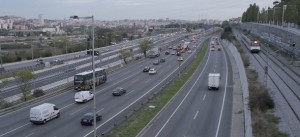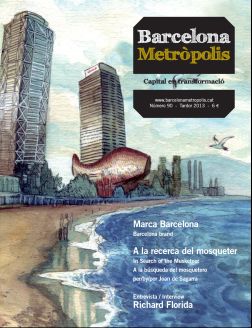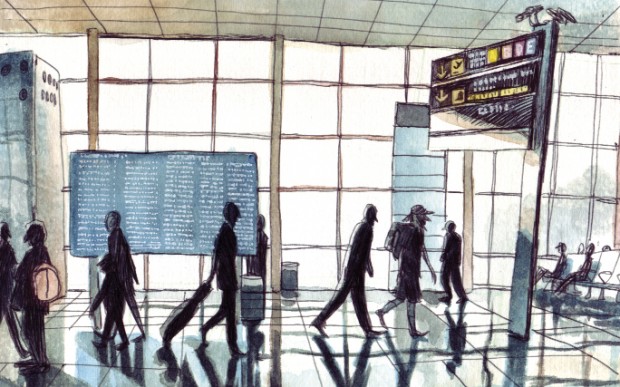Barcelona is expanding, constantly creating centres of excellence outside its walls, expanding the residential area, conforming to the European metropolis. The resident population wants a better metropolis and this calls for greater planning.
All major cities change, but not in the same way; European cities in general are subject to transformation processes that, on the one hand, expand their influence and on the other “reduce” their size. When a city loses population and activities because they are relocated to other areas (they emigrate), it is regarded as a sign of a crisis in the regional order. However, and while difficult to accept, the truth is quite the opposite: it is success that leads to emigration. A city’s success always attracts more people who want to enjoy its quality, its services and facilities, which grow constantly. But the city’s value increases at the same time and it therefore becomes increasingly more expensive while the disadvantages of congestion are heightened. At this point, which is almost crucial, the population and activities move to nearby areas to escape the high costs and the negative aspects of the larger size, leading to the development of a regional metropolis (which is neither compact nor dense and offers possibilities of continuity).
The phenomenon of the “construction” of this metropolis is simple, because it is a real alternative that allows people to enjoy the benefits of agglomeration (the size) without overcrowding. In summary, the population benefits from the advantages of a metropolis without having to put up with its negative aspects. This is possible because urban morphology and urban condition, which have always been regarded as inseparable, are now projected as two different concepts. We can “benefit” from the urban condition, more particularly the metropolitan condition, in the absence of a traditional morphology. The reasons are to be found in the distribution of functions in space, in the dissemination of networked relationships and the increased mobility of families and goods. In this case, all the whole area affected by the phenomenon has functions (residence, private services, public facilities, etc.), both banal and quality ones, which are used by the entire population living in any part of the large area.
Parallel to this, the “centre”, or main city (in this case, Barcelona), modifies its capacity to attract people and fewer families and individuals wish to settle there, although temporary flows of population (stays for tourism, for work reasons, for shopping, etc.) become greater, a reality that expands the influence of the centre as the territorial recognition of the metropolis spreads (the names of Barcelona, Venice, Porto and Marseilles, etc. refer not only to the traditional area, but also to the wider, urbanised area that includes other towns, scattered houses, industrial and service centres, etc.).
One paradigmatic example that illustrates this phenomenon perfectly is the case of the Japanese, Australians, Americans, etc., who buy the “Venice package” and are offered accommodation in hotels in other towns outside Venice, sometimes more than an hour away by bus, but they believe they are staying in… Venice. Every morning they are shuttled by bus to Venice, i.e. the Venice they know from the movies, photographs and postcards, and are not at all surprised: they think they are sleeping in the Venice metropolis that is part of the historic city.
Nevertheless, one last factor should be mentioned: the proliferation of low-cost air travel (Ryanair is one of the main players behind this reality and its consequences) not only multiplies accesses with a basically European-wide coverage, increasing, in turn, the entry points, but also distorts the perception of urban and metropolitan organisation. For example, choosing Girona Airport as the main airport to link Barcelona to the rest of Europe, or Treviso to connect Venice, eventually expands the perception of space. Girona is regarded as part of Barcelona, and Treviso as part of Venice (in one sense, beyond their material nature, Barcelona and Venice, in our example, are abstractions; they do not conform a defined area). The Ryanair flight timetables refer to Venice-Treviso or Barcelona-Girona, as if they were the same thing, fuelling that perception, or, to put it more accurately, giving both cities a broader territorial unity (metropolis).
Is this a misconception? We might say that it is not. Besides administrative links, beyond the lack of understanding of politicians and possible identity emergencies in the population of each place, what appears to be occurring at present is the (perhaps unconscious) acknowledgement of the new regional metropolis, particularly in Europe. The regional metropolis (which may have other names, such as the “city of cities”, “metropolitan archipelago”, etc.), whenever it “designates a city” (Barcelona), defines and delineates a more extensive area connected by functional, economic, social and cultural relationships. There is a great central city, from which it takes its name, but the fact is that it conforms to a new reality that connects different entities, different functions and diverse populations. It is not a compact whole, but an articulated reality that gives itself, so to speak, to an extensive area. This new organisation of space may be termed European metropolis, where European does not have the meaning of a place attribute, but rather as a species (specific organisational form, relationship functions, establishment of the population, etc.). It is a recent change that corresponds to a particular form of urban gigantism that seems to prevail in the international arena, taking advantage of the large European urban fabric.
Barcelona is perhaps one of the best examples of this transformation in spatial organisation. The metropolitan city of Barcelona (in this case let us forget its political and administrative problems) has lost its status as a metropolitan area to take on that of a European-type Barcelona metropolis (or, as Oriol Nel·lo would say, a “city of cities”).
A “metropolitan city” is characterised by a strong hierarchy, which places the main city at the top of the hierarchical pyramid and all the other nuclei as dependent parts of it. Because “everything” (figuratively speaking) is to be found in this apical city: the best services, the best cultural centres, the best schools, public government agencies, financial and communications centres, etc. Agglomeration has shaped this phenomenon of the accumulation of functions, capital and population, often in a “limited” space with a pendulum-like population flow and a one-way goods flow.
This is not a chance phenomenon. In fact, the economic dynamic, traditional positional goods and accumulation of productive and innovative energies have continued to attract population and capital to the “centre”, a situation that overall produces services, installations and… quality. This process is plunged into crisis when the disadvantages of agglomeration outweigh its advantages (for the population and for activities) and when changes in lifestyle, technological progress, increased mobility opportunities, distance relationships, etc., allow us to enjoy the advantages of agglomeration without having to suffer it directly.
Gradually in some cases, and more rapidly in others, governed in certain situations or self-organised in others, population and activities move, within the broader region, to smaller cities or to the developed countryside, breaking the rigid hierarchical structure and determining the transition from a rigid hierarchy to a more flexible one. This exodus of activities and people spawns new demands for private services, while also claiming the right to collective services. In the first phase, these areas are hyper-equipped with private facilities (shopping centres, entertainment centres, etc.), but a workable balance is subsequently reconstructed between private and public services (parks, universities, research centres, health centres, etc.).

© Albert Armengol
Movements of people and goods in a metropolitan city are unidirectional, from the periphery to the centre, whereas in a regional metropolis such as Barcelona they are multidirectional. In the image, the B-23 motorway and the Renfe R4 railway line as they pass through the district of Baix Llobregat.
The metropolis expands, but comfortably. Every morning, underground lines, buses, trains and private cars carry to Barcelona (city) workers, students and other people who need to fulfil their needs in the city’s organisations or facilities. But these same underground lines, trains, buses and cars also carry a large population from Barcelona (city) to the regional metropolis where there are universities, economic activities, service centres, etc. Moreover, and at the same time, many people are moving across the region. Movements of population and goods in a metropolitan city are one-way, from the periphery to the centre, and are multi-directional in the regional metropolis.
Barcelona does not expand by displacing less important elements (in the sense of production, services and quality), but by constantly creating centres of excellence beyond its walls, expanding the residential area and forming the European metropolis. In a sense, and as if with its name it covered an increasingly broader area, a ever larger part of the population relates increasingly more to this name, and its influence (in culture, lifestyles, innovation, etc.) continues to grow and push the confines and the perception of the metropolis further outwards. This reality is not the result of a power that is intrinsic to it, but is due rather to the capacity to promote, in a broader regional context, innovations, wider-ranging relationships and integration capacity. It is a process that governmental authorities often fail to understand and seek to hamper, when what they should be doing is trying to promote it and plan it. The resident population wants a better metropolis, so we need greater planning.




